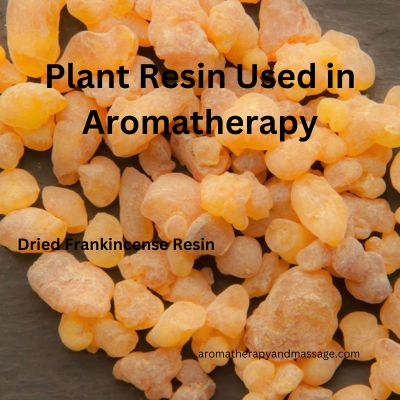- Home
- Guide for Essential Oil Use
- Plant Resin Used in Aromatherapy
As an affiliate for Bookshop, Amazon, and other programs, I may earn a small commission for products purchased through links. This doesn't affect the price you pay. Privacy policy and disclosures.
Search this site:
What is Plant Resin Used in Aromatherapy?
Although resin collected from trees has many uses, including as incense, plant resin used in aromatherapy is distilled to produce essential oil or solvent-extracted to make an absolute.
Resin is a thick, sometimes solid, sticky substance that some woody plants produce in special resin cells. The substance forms from oxidation of the plant's natural essential oils. Usually, resin is secreted in cavities or passages and frequently oozes out through the bark to cover injuries and protect the plant from insects, parasites, and other pathogens.
Obtaining resins to use in commercial products typically requires tapping trees. When done correctly, tapping does not harm the tree and is a sustainable method for extracting the resin.
Types of Plant Resin Used in Aromatherapy
Plant resins come in three types: hard resins, oleoresins, and gum resins. Hard resins contain minimal amounts of essential oil and are not water soluble. Their primary use is in varnishes and adhesives.
Resins used in aromatherapy are oleoresins and gum resins.
Important note: Terms pertaining to resins are not used consistently throughout the aromatherapy industry. Often, a source will simply refer to resin. Just make sure you know what you are buying.
Oleoresins
Oleoresins are often a viscous, sticky liquid and contain a lot of essential oil. They have a distinct aroma and flavor. When tapped from the tree, oleoresins are not water soluble (they dissolve in alcohol and other solvents); however, you can buy oleoresins that have been processed to make them water soluble.
The most widely used oleoresin is turpentine, mostly from pine trees. It is a solvent used in shoe polish, varnish, paint, and waterproofing, and not used in aromatherapy.
Trees belonging to the Pinaceae family, which include cedar, fir, hemlock, pine, and spruce, make oleoresins. However, essential oils from those trees are commonly produced from other parts of the tree—needles, wood, etc.
Essential oils produced from oleoresins include:
- Elemi (Canarium luzonicum)
- Copaiba (Copaifera officinalis)
- Balsam of Tolu (Myroxylon balsamum) and Balsam of Peru (Myroxylon pereirae) from the Fabaceae family. (Note: A balsam is an oleoresin that contains benzole or cinnamic acid. Contrary to their names, copaiba balsam (Copaifera officinalis) and Canadian balsam (Abies balsamea) are not true balsams.)
- Benzoin from plants belonging to the Styrax family, such as Siam benzoin (Styrax tonkinensis) and Sumatra benzoin (Styrax benzoin). (Note: Benzoin is an absolute that's solvent-extracted from the oleoresin, not a steam-distilled essential oil.)
Gum Resins
First, we need to define a gum. Gummosis is a process in which some woody plants break down internal tissues, in particular cellulose, to produce a high-sugar sap called gum. Like resin, gum seals wounds and protects against invading insects. (Note that while gum is a type of sap, resin is not.)
Unlike resin, gums are water soluble. The food industry commonly uses them as thickening agents, emulsifiers, and stabilizers (for example, acacia gum or guar gum). Other uses for gums include making chewing gum, and in adhesives, paper, and printing. Essential oils are not made from gums.
However, essential oils are produced from gum resins, which are a combination of gum and resin. Most trees that produce gum resins grow in dry climates. Examples include galbanum and trees of the Burseraceae family, including frankincense, myrrh, and opopanax.
Gum resins are partially soluble in water and mostly soluble in alcohol. You might see them referred to as oleo-gum resins. A processed gum resin might be called a resinoid.
Sources
Bella Martinez, "What Are Resins? The Benefits, Properties And More!" March 02, 2018. Retrieved from https://www.edensgarden.com/blogs/news/what-are-resins on November 13, 2023.
Donald Miller, "The Difference Between Tree Sap & Tree Resin," May 09, 2018. Retrieved from https://sciencing.com/difference-between-tree-sap-tree-resin-12296179.html on November 13. 2023.
Dr. Erich Fred Legner, Professor of Biological Control, University of California Riverside, "Gums & Resins," Retrieved from http://www.faculty.ucr.edu/~legneref/botany/gumresin.htm#:~:text=Gum%20resins%20occur%20naturally%20as,of%20the%20Umbelliferae%20and%20Burseraceae on November 13, 2023.
Kathy Sadowski, MS in Aromatherapy, RA, LMT, "The Difference between Resins and Gums for Aromatherapy Use," February 10, 2020. Retrieved from https://naha.org/naha-blog/the-difference-between-resins-and-gums-for-aromatherapy-use/ on November 13, 2023.
Mountain Rose Herbs, "What are Resins and Gums in Plants?" March 11, 2021. Retrieved from https://blog.mountainroseherbs.com/resins-and-gums-in-plants on November 13, 2023.
The Daily Garden, "Gums," November 27, 2019. Retrieved from https://www.thedailygarden.us/garden-word-of-the-day/gums on November 13, 2023.
Buy essential oils: Aromatics International or Rocky Mountain Essential Oils.
Photo Credit: xbqs42 from Pixabay.




